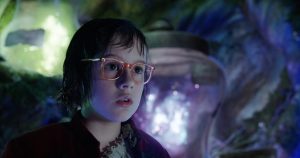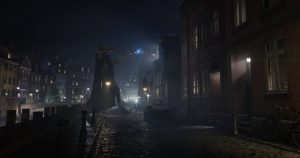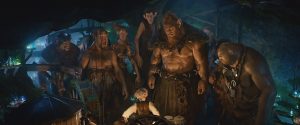![]()
As a boy, my favorite author by a country mile was Roald Dahl. Obviously, his tales, which include “Charlie and the Chocolate Factory” and “James and the Giant Peach” among many others, were always incredibly imaginative. Still, I think that I most appreciated the author’s embrace of darker story elements (always peppered with a sense of humor). His young protagonists were often put through the ringer. Dahl had an amusing way of putting the screws to any character with traits that he found repellent or rude – it never mattered if it was a child or an adult. As a young reader, I always felt that he wasn’t patronizing me or sanitizing elements.
 The latest Dahl adaptation comes from famed director Steven Spielberg in the form of The BFG. It’s an incredibly slick and well-produced effort that impresses visually and follows the original tale fairly closely (if memory serves, it only alters a couple of elements, mostly towards the close). Yet in a strange way, following several aspects so meticulously ultimately hobbles the movie. The end result is cute, with a couple of amusing moments, but also sluggishly paced and dramatically lifeless.
The latest Dahl adaptation comes from famed director Steven Spielberg in the form of The BFG. It’s an incredibly slick and well-produced effort that impresses visually and follows the original tale fairly closely (if memory serves, it only alters a couple of elements, mostly towards the close). Yet in a strange way, following several aspects so meticulously ultimately hobbles the movie. The end result is cute, with a couple of amusing moments, but also sluggishly paced and dramatically lifeless.
Sophie (Ruby Barnhill) is a lonely orphan whose life is turned upside down after witnessing a large and strange figure wandering the city streets in the dead of night. She’s quickly abducted by The BFG (Mark Rylance) a “big, friendly giant” with an odd, “squiggly” manner of speech and a flair for passing gas. He takes Sophie to his home, where she learns that he collects dreams and delivers them at night to the sleeping citizens. Unfortunately, The BFG is bullied by his fellow giants, who are cannibals that will eat any human they can get their hands on. Together, the two new friends set out to stop the villains.
 On a purely technical level, it’s flawless. There are incredibly choreographed and elaborate long shots that follow Sophie through various giant-world environments. The highlight includes her cross into the land of dreams, where the camera follows her through water, flips upside down and continues with the girl as she enters the magical land. There are some very effective moments when The BFG slinks through city streets, and evades being seen by careful and creative lunges into the shadows.
On a purely technical level, it’s flawless. There are incredibly choreographed and elaborate long shots that follow Sophie through various giant-world environments. The highlight includes her cross into the land of dreams, where the camera follows her through water, flips upside down and continues with the girl as she enters the magical land. There are some very effective moments when The BFG slinks through city streets, and evades being seen by careful and creative lunges into the shadows.
 Yet it’s all so ornate that it often feels flat. The performers are excellent, but The BFG CGI takes a bit of getting used to. Sophie’s lines are a little too smart-alecky at times and there’s just a strange lack of chemistry between the two friends (even though they share plenty of annoyingly doe-eyed stares). The emotion comes across as forced. While impressive to look at, when the title character takes Sophie on a dream-collecting journey, it goes on and on to the point of tedium. And everything feels watered down, with grimmer elements described rather than shown.
Yet it’s all so ornate that it often feels flat. The performers are excellent, but The BFG CGI takes a bit of getting used to. Sophie’s lines are a little too smart-alecky at times and there’s just a strange lack of chemistry between the two friends (even though they share plenty of annoyingly doe-eyed stares). The emotion comes across as forced. While impressive to look at, when the title character takes Sophie on a dream-collecting journey, it goes on and on to the point of tedium. And everything feels watered down, with grimmer elements described rather than shown.
The result is a very leisurely paced film that never develops a whole lot of tension and frankly, feels a bit dull. Thankfully, when the pair meet up with The Queen and her consortium late in the film, events liven up briefly. It actually results in the most amusing sequence in the movie, simply because there are more people for the title character to play off of. However, it all comes too late to really make a big difference.
Overall, The BFG is too slick, polished and sanitized for its own good. Kids will certainly enjoy sections of it, but it never quite finds its footing and doesn’t even provide the sense of awe and wonder you’d expect from a Spielberg production. If you want to see a Roald Dahl adaptation that really captures the spirit of the author, I’d highly recommend Nicolas Roeg’s The Witches (1990), Danny DeVito’s Matilda (1996) or Wes Anderson’s The Fantastic Mr. Fox (2009). They keep both the general feel and biting edge of Dahl’s work fully intact.


